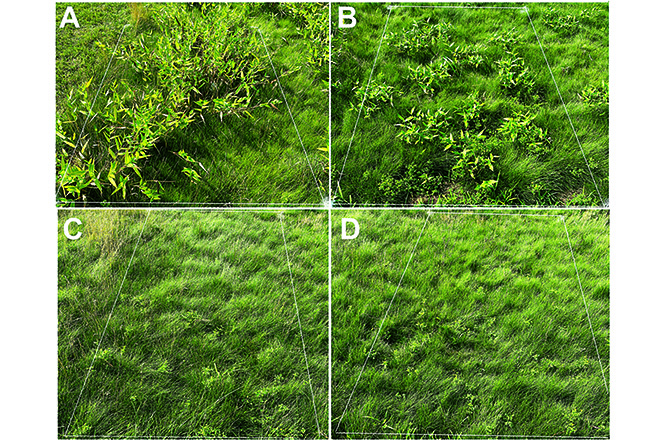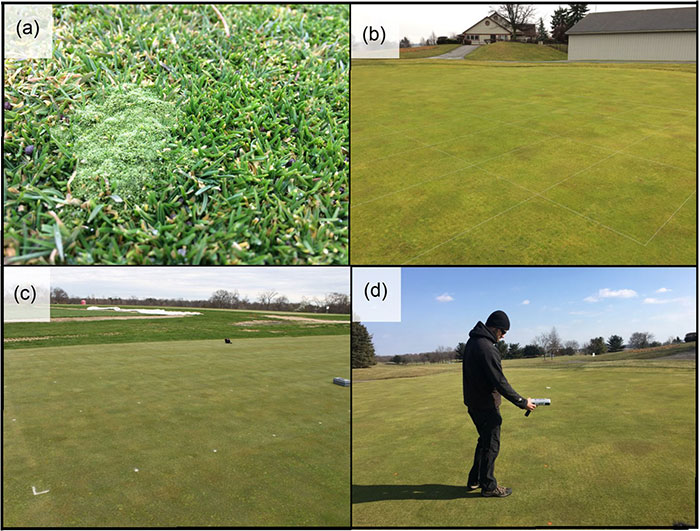Super Science: Weed control in fine fescue rough

Researchers at Rutgers University evaluate herbicide treatment timing in combination with nonmowed and infrequent mowing of fine fescue golf course rough. A) Nonmowed and no herbicide, B) Mowed June 9 and July 7, 2021, C) Prograss and D) Proxy plus Primo Max. (Photo: Mike Kenna, Ph.D.)
Weed control for “naturalized areas” on golf courses can be difficult without the application of herbicides. Central Region USGA Green Section Agronomist Zach Nicoludis, in his August update, discussed herbicide programs.
Adequate weed control is possible with a combination of preemergence herbicides, broadleaf weed herbicides and grassy weed herbicides. Mixing products for application can improve efficiency, but there must be an understanding of how certain products interact to reduce effectiveness.
Nicoludus suggests using herbicides such as sethoxydim, fluazifop and fenoxaprop for grassy weed control in fine fescue naturalized areas. However, be aware of the dangers of mixing grassy weed control products such as MCPA or 2,4-D. Aaron Patton, Ph.D., says it is best to apply grassy and broadleaf weed control products separately. Wait at least seven days between applications if 2,4-D or MCPA is used first and at least two days between applications if sethoxydim, fluazifop or fenoxaprop is applied first (Patton).
At Rutgers University, Matt Elmore, Ph.D., and graduate student Katie Diehl work on deer-tongue grass (Dichanthelium clandestinum) control in fine fescue (Festuca spp.) rough. Deer tongue is a broad-bladed perennial native to the eastern United States. The branching growth habit can form a dense canopy that reduces the playability of golf course rough.
Currently, deer-tongue grass is removed manually or with applications of glyphosate. However, studies evaluating glyphosate safety for fine fescue injury are inconsistent. The selective herbicide fluazifop can be effective, but only if applied sequentially at three-week intervals. The researchers conducted experiments at the Mendham Golf and Tennis Club (Mendham, N.J.) and found that glyphosate still performed better than fluazifop. Glyphosate applied at 175 growing degree days (GDD) (base 50 degrees F) and spring-flowering provided greater control (89 and 97 percent) than glyphosate used at 75 GDD and 25 cooling degree days (base 68 degrees F) and all fluazifop treatments (11 to 59 percent) on Oct. 22, 2020.
Elmore and Diehl presented a new experiment combining mowing practices with herbicide and plant growth regulator treatments at the Rutgers Turfgrass Field Day (see Figure 1). This research is in its first year and is already showing some interesting results. Mowing the Beudin hard fescue and Quatro sheep fescue rough on June 9 and July 7, 2021, reduced deer tongue grass compared to the nonmowed plot. Also, Proxy (5 fluid ounces per 1,000 square feet) plus Primo Max (25 fluid ounces per acre) was better than the nonmowed and no-herbicide plot. They will continue to monitor spring and fall applications of glyphosate, fluazifop, ethofumesate (Prograss) and Turflon Ester in combination with the mowing schedule.
Additional Information
Nicoludis, Zach. 2021. Make Every Herbicide Application Count. USGA Green Section Central Region Update. 2 pp.
Diehl, Katie H., Matthew T. Elmore, and Phillip L. Vines. 2021. Herbicide Application Timing Affects Deer-tongue Grass (Dichanthelium clandestinum) Control in Native Areas in Proceedings of the Thirtieth Anniversary Rutgers Turfgrass Symposium. p 27.
Patton, Aaron, ed. 2019.Turfgrass Weed Control for Professionals (TURF-100). Purdue University Extension. 128 pp.












